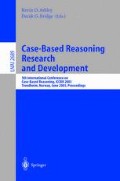Abstract
The definition of similarity measures is one of the most crucial aspects when developing case-based applications. In particular, when employing similarity measures that contain a lot of specific knowledge about the addressed application domain, modelling similarity measures is a complex and time-consuming task. One common element of the similarity representation are local similarity measures used to compute similarities between the values of single attributes. In this paper an approach to learn local similarity measures by employing an evolution program— a special form of a genetic algorithm— is presented. The goal of the approach is to learn similarity measures that sufficiently approximate the utility of cases for given problem situations in order to obtain reasonable retrieval results.
Access this chapter
Tax calculation will be finalised at checkout
Purchases are for personal use only
Preview
Unable to display preview. Download preview PDF.
References
R. Bergmann, M. M. Richter, S. Schmitt, A. Stahl, and I. Vollrath. Utility-oriented matching: A new research direction for Case-Based Reasoning. In Professionelles Wissensmanagement: Erfahrungen und Visionen. Proceedings of the 1st Conference on Professional Knowledge Management. Shaker, 2001.
A. Bonzano, P. Cunningham, and B. Smyth. Using introspective learning to improve retrieval in CBR: A case study in air traffic control. In Proceedings of the 2nd International Conference on Case-Based Reasoning. Springer, 1997.
K. Branting. Acquiring customer preferences from return-set selections. In Proceedings of the 4th International Conference on Case-Based Reasoning. Springer, 2001.
A. Göker. Capturing information need by learning user context. In Working Notes of the Workshop on Learning about Users, 16th International Joint Conference in Artificial Intelligence, 1999.
J.H. Holland. Adaptation in Natural and Artificial Systems. The University of Michigan Press, 1975.
J. Jarmulak, S. Craw, and R. Rowe. Genetic algorithms to optimise CBR retrieval. In Proceedings of the 5th European Workshop on Case-Based Reasoning. Springer, 2000.
D. Leake, A. Kinley, and D. Wilson. Linking adaptation and similarity learning. In Proceedings of the 18th Annual Conference of the Cognitive Science Society. Hillsdale, NJ: Lawrence Erlbaum, 1996.
Z. Michalewicz. Genetic Algorithms + Data Structures = Evolution Programs. Springer, 1996.
F. Ricci and P. Avesani. Learning a local similarity metric for case-based reasoning. In Proceeding of the 1st International Conference on Case-Based Reasoning, pages 301–312. Springer, 1995.
B. Smyth and M. T. Keane. Retrieving adaptable cases: The role of adaptation knowledge in case retrieval. In Proceedings of the 1st European Workshop on Case-Based Reasoning. Springer, 1993.
A. Stahl. Learning feature weights from case order feedback. In Proceedings of the 4th International Conference on Case-Based Reasoning. Springer, 2001.
A. Stahl. Defining similarity measures: Top-down vs. bottom-up. In Proceedings of the 6th European Conference on Case-Based Reasoning. Springer, 2002.
D. Wettschereck and D. W. Aha. Weighting features. In Proceeding of the 1st International Conference on Case-Based Reasoning. Springer, 1995.
W. Wilke and R. Bergmann. Considering decision cost during learning of feature weights. In Proceedings of the 3rd European Workshop on Case-Based Reasoning. Springer, 1996.
Z. Zhang and Q. Yang. Dynamic refiniement of feature weights using quantitative introspective learning. In Proceedings of the 16th International Joint Conference on Artificial Intelligence, 1999.
Author information
Authors and Affiliations
Editor information
Editors and Affiliations
Rights and permissions
Copyright information
© 2003 Springer-Verlag Berlin Heidelberg
About this paper
Cite this paper
Stahl, A., Gabel, T. (2003). Using Evolution Programs to Learn Local Similarity Measures. In: Ashley, K.D., Bridge, D.G. (eds) Case-Based Reasoning Research and Development. ICCBR 2003. Lecture Notes in Computer Science(), vol 2689. Springer, Berlin, Heidelberg. https://doi.org/10.1007/3-540-45006-8_41
Download citation
DOI: https://doi.org/10.1007/3-540-45006-8_41
Published:
Publisher Name: Springer, Berlin, Heidelberg
Print ISBN: 978-3-540-40433-0
Online ISBN: 978-3-540-45006-1
eBook Packages: Springer Book Archive

